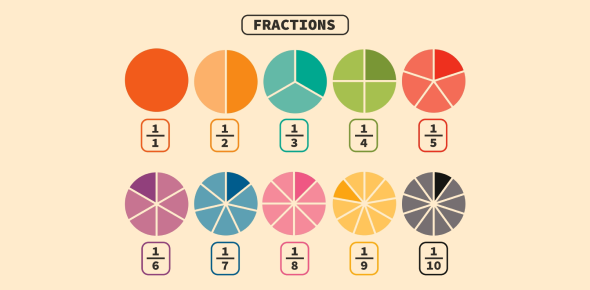What Is Fractions Numerators, Denominators, and Simplification? Explore Its Types, Uses & More
Lesson Overview
Fractions are a fundamental concept in math that represent parts of a whole. We use fractions in everyday life - whether we are sharing a pizza, telling time, or measuring ingredients. Understanding fractions and how they can be simplified or expressed in equivalent forms helps us solve problems more accurately and efficiently.
What Is a Fraction?
A fraction is a number that represents a part of a whole. It has two main parts:
- Numerator (Top Number): Tells how many parts are being considered.
- Denominator (Bottom Number): Tells how many total equal parts the whole is divided into.
Example:
If a rectangle is divided into 5 equal parts and 2 parts are shaded, the fraction representing the shaded area is:
| Fraction | Meaning |
|---|---|
| 2/5 | 2 shaded parts out of 5 total parts |
Visual Representation of Fractions
Fractions can be shown using diagrams. These visuals help us understand how parts of a whole are represented.
Example:
A circle is divided into 7 equal parts, and 2 parts are shaded.
Understanding Numerator and Denominator
The numerator and denominator work together to describe a part-whole relationship.
| Fraction | Numerator | Denominator | Meaning |
|---|---|---|---|
| 3/8 | 3 | 8 | 3 parts out of 8 total |
| 5/6 | 5 | 6 | 5 parts out of 6 total |
Simplifying Fractions
Simplifying a fraction means writing it in its lowest terms. This is done by dividing both the numerator and the denominator by their Greatest Common Factor (GCF).
Steps to Simplify a Fraction:
- Find the GCF of the numerator and denominator.
- Divide both numbers by the GCF.
Example:
Simplify 3/15
- GCF of 3 and 15 = 3
- 3 ÷ 3 = 1
- 15 ÷ 3 = 5
- Simplified Form = 1/5
| Original Fraction | GCF | Simplified Form |
|---|---|---|
| 3/15 | 3 | 1/5 |
| 4/8 | 4 | 1/2 |
| 6/9 | 3 | 2/3 |
Take This Quiz
Equivalent Fractions
Equivalent fractions are different fractions that represent the same value.
How to Find Equivalent Fractions:
- Multiply or divide both the numerator and denominator by the same number.
Example:
1/2 is equivalent to:
- (1 × 2) / (2 × 2) = 2/4
- (1 × 3) / (2 × 3) = 3/6
- (1 × 4) / (2 × 4) = 4/8
Comparing and Recognizing Equivalent Fractions
To check if two fractions are equivalent:
- Simplify both fractions.
- If they simplify to the same value, they are equivalent.
Example:
Are 12/36 and 1/3 equivalent?
- Simplify 12/36
GCF = 12
12 ÷ 12 = 1
36 ÷ 12 = 3
Yes, they are equivalent.
Table of Simplified and Equivalent Fractions
| Fraction | Simplified Form | Equivalent To | Simplest Form? |
|---|---|---|---|
| 3/15 | 1/5 | Yes | No |
| 12/36 | 1/3 | Yes | No |
| 1/3 | 1/3 | N/A | Yes |
| 2/7 | 2/7 | N/A | Yes |
| 15/20 | 3/4 | Yes | No |
Take This Quiz
Rate this lesson:
 Back to top
Back to top

